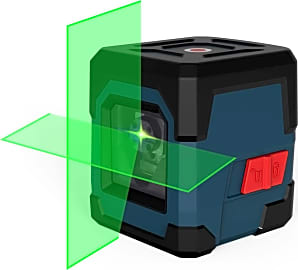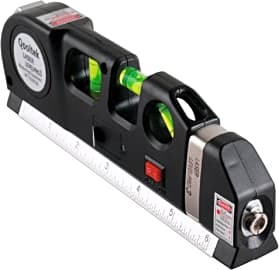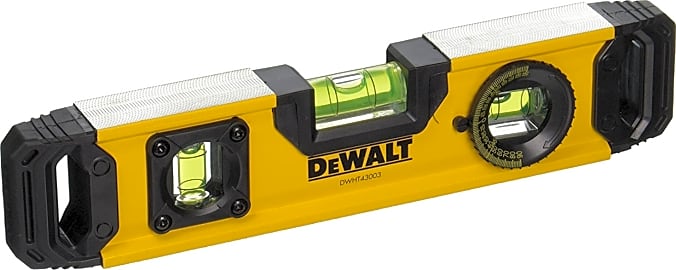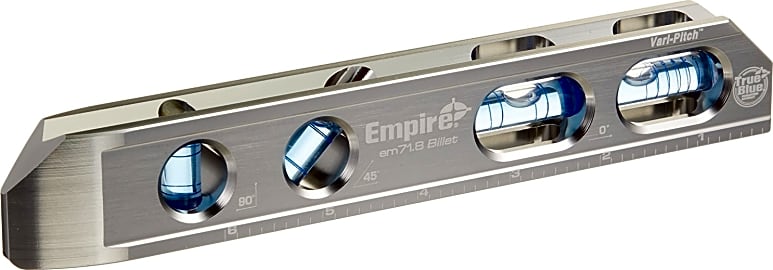The 10 Best Levels

This wiki has been updated 43 times since it was first published in September of 2015. It's hard to imagine any job that doesn't need a level, from furniture making, to hanging tiles, pictures, shelving or mirrors, to home construction. Find the perfect model for your next project from our comprehensive selection, which includes both traditional bubble styles and digital models, in a variety of tough materials, including ABS plastic and durable, lightweight aluminum. When users buy our independently chosen editorial choices, we may earn commissions to help fund the Wiki.
Editor's Notes
December 03, 2020:
As with many things nowadays, technology progresses quickly, so predictably, digital levels are becoming ever more popular and can ensure precise readings in a range of measurements, including percentage, degrees, and pitch. As such, the update to this ranking reflects the most recent advances within this category.
That being said, technology doesn't render the traditional methods obsolete, and many tradesmen undoubtedly prefer to use a spirit level with a vail. Two options made by Stanley, the Stanley FatMax Box, and the Stanley 42-324 I-Beam, were consolidated into a single option, the Stanley FatMax I-Beam. This recent model takes the rigid design and durability of previous models and improves it with magnified vails and better quality end caps that prevent damage if dropped. Unfortunately, it isn't available in an extra-long version, but for those requiring length as well as durability, the Irwin Tools 1000 I-beam comes in a range of sizes up to 96 inches, and most recently, in digital versions, too.
The Stabila Pocket Pro V2 was originally selected due to its compact size, which allowed it to be carried in a belt pouch or pocket. We decided to replace it with the RockSeed Line Laser, which is equally as portable, but much more useful. This laser level has a range of fifty feet, and is waterproof and impact-resistant, making it an ideal choice for tradesmen.
Finally, we added the Motorhead Smart Digital, an innovative option that displays the exact angle in percentage, degrees, and pitch. It is milled from a solid aluminum block making it a very sturdy and precise tool, while a padded carrying sleeve prevents it from getting damaged when not in use.
July 16, 2019:
Whether you prefer a laser level or a traditional spirit level (like most featured here), they’ll help ensure your pictures are hung straight and your tiles are affixed properly. Levels are a must for any carpenter or interior decorator who needs to line up materials or identify angles multiple times on a daily basis. All of the selections here have stood the test of time and can be trusted to produce consistently accurate readings.
Retaining its top spot is the Stanley 42-324 I-Beam, a refreshingly low-priced choice that’s durable and easy to use, with shock-absorbent end caps and a protective, powder-coated frame. It’ll hold up under stress, thanks to that coating, as well as sturdy, acrylic vial covers. You can buy it with confidence, thanks to the manufacturer’s lifetime warranty. Its vials are easy to read, and it offers a convenient, 180-degree rotating view.
A high-quality choice that will hold firmly onto all metal materials is the Irwin Tools 1000 I-beam, which is built with a magnetic strip that runs its entire length. Its rotating dial makes quick work of finding the exact angle you’re looking for. It’s great for jobs that involve leveling pipes, due to its v-groove edge. And what’s more, the manufacturer guarantees it to be accurate for life. With everything it has to offer, it is good value for its price.
If you prefer laser functionality, you can’t go wrong with the Swanson SVT200 9-Inch Savage, which features a large green, backlit display that’s bright enough to see on any worksite. The screen conveniently inverts when you turn it upside down, and the audio alerts come in handy when it achieves either level or plumb states.
Special Honors
Sola This Austrian based company make a range of high-quality levels, including a digital option that has a Bluetooth interface, allowing it to be used with the free Sola Measures app. Thes provides a range of practical additional functions, such as remote readings, remote control of measurement functions, and managing and documenting readings. sola.at
A Brief History Of The Level
This helps to avoid broken vials even when the level is used in freezing temperatures.
Whether you're a carpenter, an interior decorator, or an installation artist, If you want to get things straight, you need to use a level. These humble, handy devices use the basic physical attributes of gravity and buoyancy to help you identify angles quickly and accurately. And as simple as the properties at play within a level may be, there's more than meets the eye with these time honored tools, both in terms of function and history.
Let's take a step back to a time before builders and DIY hobbyists alike could buy a cheap, reliable level any time they pleased.
Early leveling devices were used to help builders erect everything from the pyramids at Giza to the Parthenon to the Coliseum and beyond. A simple level can be devised using a weighted object suspended below a carefully measured tripod, with the tilt of the string checked to establish a 90 degree angle (or to observe a lack thereof). Even an act so simple as placing a sphere on a flat surface can help to check how level it may or may not be, and determine the direction of tilt should it exist.
The first known level approximating the modern design was not invented until sometime in the mid 17th Century, likely in the year 1661. That was the year in which the letters of French inventor, scientist, cartographer, and author Melchisédech Thévenot first make mention of his new device, an early but functional bubble level. It took several decades for use of Thévenot's invention to become widespread, but by the early 1700s, levels were in wide enough use that we still have many surviving examples of these early generations of the now ubiquitous tool.
The proper name of the device usually just called a level is in the fact spirit level. This name comes from the fact that the liquid within the level's vial (that's the little glass tube with the green liquid and the bubble, for the record) is usually an alcohol such as ethanol or some other similar spirit. A spirit has a wider temperature range as a liquid than does water, thus is less susceptible to the expansion issues potentially caused by water as it freezes into its sold form, aka ice. This helps to avoid broken vials even when the level is used in freezing temperatures.
Projects That Call For Level Usage
If you're trying to hang a single framed picture in your home, chances are that you can manage to get it looking ostensibly parallel to the ground without use of a level. However, if you're hanging multiple photos or paintings (or other pieces of media) in line with each other, then the eye will clearly be able to determine which are off level by contrasting the various frames. Hanging multiple pictures precisely, therefore, calls for a level.
Hanging multiple pictures precisely, therefore, calls for a level.
As for work in the construction field, there is no option except for precision: safety and the longevity of a building or home absolutely depend on it. Most people in the professional builder's world will have at least the occasional need to use a level. While a plumber or an electrician may get away with only occasional level usage, their work being largely tucked away behind walls and in ceilings and floors, after all, other workers will use a level almost every hour of every day of the work week.
Masons and framers in particular will see plenty of demand for a level in their work, as each angle -- be it of a layer of brick or of the beams running the length of a roof -- must be precise. That's so because all subsequent work (the next layer of bricks, for example, or the lumber attached to the frame of the roof) depends on previous precision for its own accuracy.
If you have ever seen a crew working in the middle of a city street or standing in a construction site peering through a device perched atop a tripod, you have watched people using an advanced level for the purposes of surveying. In fact, this particular surveying technique is called leveling, and it involves using an optical viewing instrument paired with a level and a distant level staff, which is a rod held upright and marked with a numerical legend. The same basic level design devised in 17th Century France still informs the layout of the modern roadway or the foundation of a skyscraper.
Features To Look For In Your Level
For certain projects, you simply must treat yourself to a laser level. Projects like placing tile, planning a long wall of hanging pictures aligned on the same axis, or other such projects where the end results will spread out over a distance and will be highly visible are made much easier thanks to that reliably straight beam cast by your level.
Most levels feature two different vials that are set perpendicular to one another, and for most people these two vials are sufficient.
Most levels feature two different vials that are set perpendicular to one another, and for most people these two vials are sufficient. One allows for easy establishment of properly upright positioning, while the other allows for proper alignment horizontal to the ground. However, if your work (or at least the project at hand) calls for precise angles that are anything other than 180 or 90 degrees in orientation, look for a level with vials set at angles to help you ensure your work remains precise. (Arguably, the next most important angle is the 45 degree. Some fine levels also feature vials set at 30 degrees.)
A level with a good built in magnet can help keep your hands free while you work, helping you get the job done even when you're working alone. Some levels also feature other mounting options, such as a an adjustable screw that can used to attach the level to a pipe, beam, or piece of framing lumber as you position and then lock the material permanently in place. These locking features are great for working with non magnetic materials.
Contrary to conventional wisdom, there are also times when you will want a level that is decidedly non magnetic. From the metal studs used to hold up sheets of drywall in certain types of construction to the area under a sink filled with pipes to a project where the object you are trying to position is itself made from a metal that attracts magnets, a magnetized level can sometimes be more of a hindrance than a boon.
Non magnetic levels can more deftly and accurately be placed near iron rich metals without pulling themselves out of alignment due to the force of attraction. And they can more easily be moved out of the way once it's time to start drilling, hammering, or sinking a screw.















